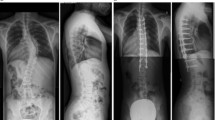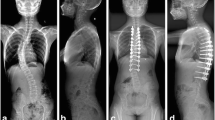Abstract
Study design
Retrospective case series.
Objectives
To compare radiographic and clinical outcomes in posterior spine fusions with pedicle screw instrumentation of varying screw densities in the treatment of adolescent idiopathic scoliosis (AIS).
Summary of background data
Posterior spinal fusion with pedicle screw instrumentation is the mainstay of surgical treatment for AIS. The most commonly used construct consists of screws placed at every level on the concave side of the deformity and nearly every level on the convex side. However, some surgeons have begun using constructs with fewer pedicle screws. The literature comparing outcomes of these differing pedicle screw constructs is limited.
Methods
Fifty-two consecutive cases of posterior spinal fusions for AIS performed by four surgeons were reviewed. High screw density constructs were used in 26 cases and limited screw density constructs in 26 cases. Construct characteristics and radiographic measurements were compared preoperatively and at last follow-up. Operative time and estimated costs were also evaluated. Student t tests were used to compare the groups with p <.05 considered significant.
Results
There was no significant difference in magnitude of correction for the high versus limited screw density group initially (38.5° vs. 34.9°, p =.093) or at final follow-up (36.9° vs. 32.2°, p =.054). Sagittal alignment, coronal balance, and translation of the major apical vertebra were comparable and stable in both groups. The high versus limited screw density group utilized significantly more pedicle screws (16.8 vs. 11.6 screws, p <.0001), had longer operative times (309 vs. 267 minutes, p =.007), and had additional estimated direct costs of $5,800.
Conclusions
Excellent curve correction, stability, and balance can be achieved using fewer screws than commonly used in posterior pedicle screw fusions for AIS. Operative time is reduced, and risk and cost are decreased with the use of limited screw density constructs.
Level of Evidence
III.
Similar content being viewed by others
References
Herring JA. Scoliosis. In: Herring JA, editor. Tachdjian’s Pediatric Orthopaedics. 4th ed. Philadelphia, PA: Saunders; 2008. p. 265–411.
Newton PO, Wenger DR. Idiopathic scoliosis. In: Morrissy RT, Weinstein SL, editors. Lovell and Winter’s Pediatric Orthopaedics. 6th ed. Philadelphia, PA: Lippincott, Williams & Wilkins; 2006. p. 693–762.
Mulpuri K, Perdios A, Reilly CW. Evidence-based medicine analysis of all pedicle screw constructs in adolescent idiopathic scoliosis. Spine 2007;32:S109–14.
Suk SI, Lee CK, Kim WJ, et al. Segmental pedicle screw fixation in the treatment of thoracic idiopathic scoliosis. Spine 1995;20:1399–405.
Dobbs MB, Lenke LG, Kim YJ, et al. Anterior/posterior spinal instrumentation versus posterior instrumentation alone for the treatment of adolescent idiopathic scoliotic curves more than 90 degrees. Spine 2006;31:2386–91.
Kim YJ, Lenke LG, Cho SK, et al. Comparative analysis of pedicle screw versus hook instrumentation in posterior spinal fusion of adolescent idiopathic scoliosis. Spine 2004;29:2040–8.
Kim YJ, Lenke LG, Kim J, et al. Comparative analysis of pedicle screw versus hybrid instrumentation in posterior spinal fusion of adolescent idiopathic scoliosis. Spine 2006;31:291–8.
Haber LL, Presented at POSNA Specialty Day, AAOS Annual Meeting 2012.
Lenke LG. Debate: Resolved, a 55 degrees right thoracic adolescent idiopathic scoliotic curve should be treated by posterior spinal fusion and segmental instrumentation using thoracic pedicle screws: Pro: Thoracic pedicle screws should be used to treat a 55 degrees right thoracic adolescent idiopathic scoliosis. J Pediatr Orthop 2004;24:329–34; discussion 338–1.
Richards S. Debate: Resolved, a 55 degrees right thoracic adolescent idiopathic scoliotic curve should be treated by posterior spinal fusion and segmental instrumentation using thoracic pedicle screws: Con: Thoracic pedicle screws are not needed to treat a 55 degrees right thoracic adolescent idiopathic scoliosis. J Pediatr Orthop 2004;24:334–7; discussion 337–8, 340–1.
Chen J, Yang C, Ran B, et al. Correction of Lenke 5 adolescent idiopathic scoliosis using pedicle screw instrumentation: does implant density influence the correction? Spine 2013;38:E946–51.
Hwang CJ, Lee CK, Chang BS, et al. Minimum 5-year follow-up results of skipped pedicle screw fixation for flexible idiopathic scoliosis. J Neurosurg Spine 2011;15:146–50.
Yang S, Jones-Quaidoo SM, Eager M, et al. Right adolescent idiopathic thoracic curve (Lenke 1 A and B): does cost of instrumentation and implant density improve radiographic and cosmetic parameters? Eur Spine J 2011;20:1039–47.
Li J, Cheung KM, Samartzis D, et al. Key-vertebral screws strategy for main thoracic curve correction in patients with adolescent idiopathic scoliosis. J Spinal Disord Tech 2014 [Epub ahead of print].
O’Brien MF, Kuklo TR, Blanke KM, et al. Spinal Deformity Study Group Radiographic Measurement Manual. Fridley, MN: Medtronic Sofamor Danek, USA; 2004.
Upasani VV, Chambers RC, Dalai AH, et al. Grading vertebral rotation without a computed tomography scan: a clinically relevant system based on the radiographic appearance of bilateral pedicle screws. Spine 2009;34:1855–62.
Li M, Shen Y, Fang X, et al. Coronal and sagittal plane correction in patients with Lenke 1 adolescent idiopathic scoliosis: a comparison of consecutive versus interval pedicle screw placement. J Spinal Disord Tech 2009;22:251–6.
Quan GM, Gibson MJ. Correction of main thoracic adolescent idiopathic scoliosis using pedicle screw instrumentation: does higher implant density improve correction? Spine 2010;35:562–7.
Gebhart S, Alton TB, Bompadre V, et al. Do anchor density or pedicle screw density correlate with short-term outcome measures in adolescent idiopathic scoliosis surgery? Spine 2014;39: E104–10.
Wang X, Aubin C, Larson A, et al. Biomechanical analysis of pedicle screw density in spinal instrumentation for scoliosis treatment: first results. In: Kotwicki T, Grivas Th B, editors. Research Into Spinal Deformities 8: Proceedings From the 9th Biennial IRSSD Meeting, Poznan, Poland, 2012. Amsterdam, Netherlands: IOS Press BV; 2012. p. 303–6.
Roach J. Moderator of: Cost Effective Spine Surgery, POSNA Specialty Day, AAOS Annual Meeting 2012.
Author information
Authors and Affiliations
Corresponding author
Additional information
Author disclosures: JWK (none); MAM (none); MDG (none); MJA (none); TFR (none).
The authors are especially grateful for the help provided by Jessica Kemppainen, PhD (University of Akron, Akron, OH), for manuscript consultation and Amy Krahe, MPT (Akron Children’s Hospital), for manuscript preparation.
This work was supported in part from donations received by Akron Children’s Hospital Foundation, specifically for orthopedic research and education.
Rights and permissions
About this article
Cite this article
Kemppainen, J.W., Morscher, M.A., Gothard, M.D. et al. Evaluation of Limited Screw Density Pedicle Screw Constructs in Posterior Fusions for Adolescent Idiopathic Scoliosis. Spine Deform 4, 33–39 (2016). https://doi.org/10.1016/j.jspd.2015.07.010
Received:
Revised:
Accepted:
Published:
Issue Date:
DOI: https://doi.org/10.1016/j.jspd.2015.07.010




